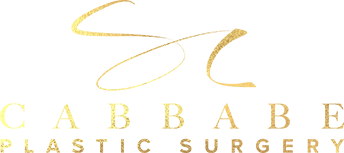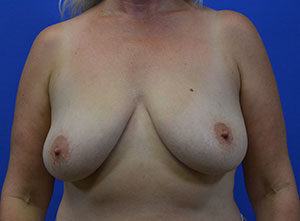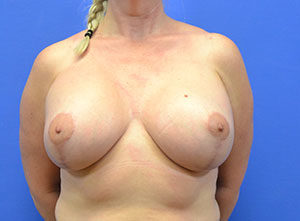Breast Augmentation-Lift Surgery
Conveniently located to serve St. Louis, Missouri
Jump To:
 When a woman with droopy breasts desires enhancement, Dr. Cabbabe often recommends a combined breast augmentation – breast lift (mastopexy) procedure. This procedure involves augmenting the breast by placing an implant or by adding fat transferred from elsewhere on the body. These procedures are more complex than a breast augmentation alone or a breast lift alone depending on the size of the implant to be added and the amount of droopiness.
When a woman with droopy breasts desires enhancement, Dr. Cabbabe often recommends a combined breast augmentation – breast lift (mastopexy) procedure. This procedure involves augmenting the breast by placing an implant or by adding fat transferred from elsewhere on the body. These procedures are more complex than a breast augmentation alone or a breast lift alone depending on the size of the implant to be added and the amount of droopiness.
A breast lift essentially removes skin and some droopy breast tissue to lift the breast and re-center the nipple and areola on the breast. A breast augmentation, on the other hand, fills and stretches out the existing breast. It is these conflicting forces that leads to a more complex operation. Therefore, the larger the implant or the more volume desired, the less skin that can be removed to fully lift the breast. For these reasons, women who have very droopy breasts with all of the breast tissue below the breast crease and the nipple – areola at the lowest point are often best served by a two – stage surgery where the breast is fully lifted then later augmented unless a very small implant is desired.
Dr. Cabbabe performs hundreds of implant surgeries each year and he uses only FDA – approved breast implants. These come with various warranties in case of rupture/leaking or capsular contracture. The current choices for a breast implant are silicone and saline. A silicone implant has a silicone shell with silicone material inside. A saline implant is composed of a silicone shell with saline or salt water inside. Silicone implants are available as round or “shaped”/“gummy bear”.
A silicone implant tends to provide a more natural look and natural feel with less rippling. Current FDA recommendations state that women <22 years of age should have saline implants; otherwise, any woman can choose whichever is preferred. FDA recommendations are for MRI screening 2 years after augmentation then every 3 years thereafter. This is to detect silent ruptures of the implant which may require further surgery. These are recommendations, not requirements and Dr. Cabbabe will review his opinion on this recommendation with you at the time of your consultation.
The expected life of an implant is approximately 15 years. If an implant ruptures and it’s saline it will generally deflate the breast and one would know immediately. If it’s silicone the patient will likely feel a small bubble or some other sort of contour change or maybe some local irritation or discomfort. Either way, it is recommended that the implants be replaced and generally, if this has been several years, both implants will be replaced at the same time. We purchase our implants with lifetime warranties so that if this occurs the company will pick up the cost for the implants themselves for the lifetime of the implants. They will even give money towards surgical fees if this occurs in the first 10 years after placement.
Dr. Cabbabe performs several types of breast lift surgeries. He believes in performing a breast lift that is long – lasting. Some surgeons will simply remove skin from the breast without re-shaping the breast. This ultimately fails because the stretched – out breast skin must support the weight of the breast and in a short of amount of time, “bottoms – out” resulting in “sunny – side up” nipples. Dr. Cabbabe, on the other hand, usually incorporates some type of removal of the droopy tissue with re-shaping of the breast which does not rely on the skin to hold the breast up, resulting in a long – lasting, natural appearance.
Peri-Areolar Breast Augmentation-Lift
If you have mild droopiness or ptosis of the breast, most of the gland of the breast above the lower breast fold or a low nipple – areola complex, Dr. Cabbabe may recommend a peri-areolar breast lift. augmentation An circular incision is placed only around the areola or pigmented area of the breast in order to lift the nipple – areola complex onto the center of the breast. The areola is reduced in size if needed.
Circumvertical Breast Lift
If you have moderate to severe breast droopiness or ptosis, most of the breast gland below the lower breast fold and a low nipple – areola complex, Dr. Cabbabe may recommend this procedure. An incision is made around the areola, reducing the size if needed. The nipple – areola is lifted and centered on the breast. The incision is extended down vertically below the nipple –areola complex to the lower breast fold in order to lift the rest of the breast and remove the droopy tissue. Droopy breast tissue is removed and the breast is narrowed and re-shaped. If a significant amount of lifting is needed, this incision may need to be extended horizontally to be hidden in the lower breast fold. Essentially, this produces an upside – down “T”, or anchor scar, which heals well on the breast.
Preparing for Surgery
Dr. Cabbabe will ask that you refrain from taking any aspirin, plavix, Coumadin, ibuprofen or any other type of blood thinner. If you are older than 40, a mammogram within one year prior to the procedure is recommended as part of normal health screening. You will have an opportunity to try implants of various sizes inside a bra which will help you determine which size implant is best for you. Dr. Cabbabe will also measure your chest width to help you determine the best fit and shape for you.
Before & After Gallery
View before-and-after pictures of real patients of Cabbabe Plastic Surgery
Surgery
Incisions are made based on pre-operative markings and planning. The implant is placed through this incision as well. Most of the time the implants are placed underneath the muscle on the chest in order to keep them where they belong on the breast and to provide some additional thickness and to reduce the risk of seeing visible ripples. This also reduces the risk of what we call capsular contracture, which is abnormally tight scarring around the implant that can distort or potentially cause pain on the chest. The implant companies have begun to offer warranties in case this happens.
Breast augmentation – lift surgery takes around 2 1/2 hours and antibiotics are given before and after the procedure, generally no drains are used and no massaging is generally needed either. Patients are able to shower the next day and go home in a bra. Early range of motion is done with the arms. Patients will generally follow-up within 1 day to 1 week and then approximately 3-4 weeks later and then in several months.
Nipple sensation and the ability to lactate are usually preserved in these procedures. Women are able to get mammograms after surgery and implants to do not interfere with breast cancer detection.
Your Breast Augmentation-Lift Surgery will be performed in a hospital or surgery center in St. Louis, MO.
Recovery
Recovery is approximately 1-2 weeks from a breast augmentation – lift procedures depending on the size of the implant used, the type of lift done and the type of work one does. Most women who have this procedure done will be up and about the next day, moving around although they may need pain medication occasionally, but most women state it was not as bad as they anticipated and most of them, if they’ve had it done on a Thursday or Friday, can usually return to work the following Monday.
Dr. Cabbabe strives to make the procedure as easy and comfortable as possible for his patients. Before surgery, patients usually receive anti-inflammatory pain medications that do not cause bleeding. At the time of surgery, local anesthesia numbing medicine is used that is long – lasting into the breast. After surgery, early range of motion is begun and pain medications are given. Dr. Cabbabe does not believe in the use of pain pumps for breast augmentation as studies have shown mixed results with their use, they are costly and they increase the risk of infections. Dr. Cabbabe has removed breast implants on patients from other practices that use pain pumps due to infection.
Complications
The complications that can occur are infections of the implant, rarely requiring the implant to be removed, or bleeding into the pocket around the implant requiring further surgery to evacuate blood or stop bleeding. Most women have some asymmetry to their breasts and most of the time the same sized implant is used on both sides but occasionally a different size implant will be used if needed. More breast tissue can be removed from the larger breast or a larger implant can be used on the smaller breast.
The greatest risk with breast augmentation – lift surgery is the need for future revisions. In select patients, this rate can approach up to 25%. This commonly includes patients who had very droopy breasts and had a large implant placed in one surgery. For this reason, Dr. Cabbabe will discuss this possibility and may recommend two – stage surgery.
Capsular contractures can occur although this has become less common in Dr. Cabbabe’s experience. An implant may rupture and further surgery would be needed during their lifetime. Finally, there are rare cancers, referred to ALCL, which have been linked to breast implants. Fortunately, these are rare and are still case reportable. They have been found in women who present with fluid around their implants after breast implant surgery.


